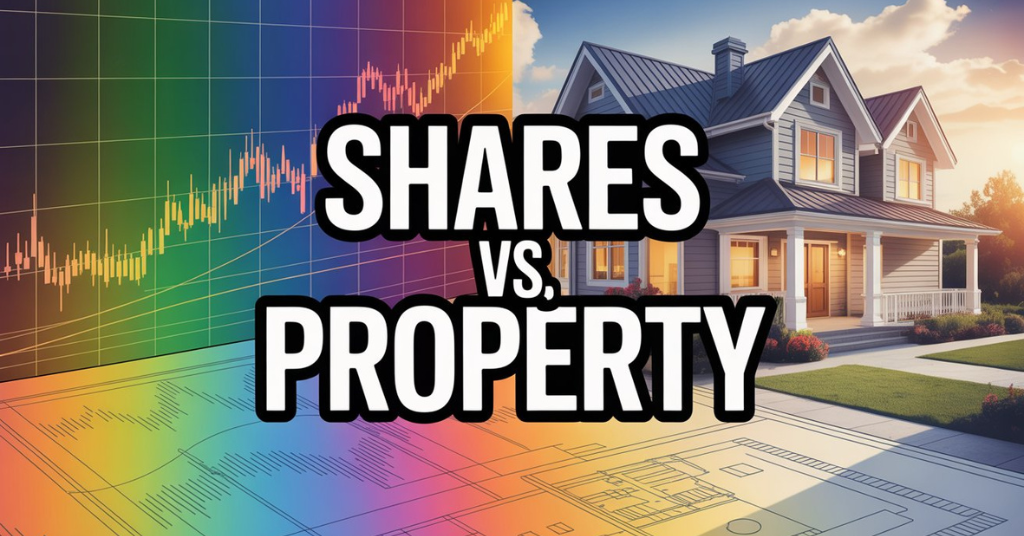When it comes to building wealth, two of the most common investment choices are shares (stocks) and property (real estate). Both are powerful vehicles, but each comes with unique risks, advantages, and strategies.
For American investors, deciding between shares vs property can be overwhelming. Should you invest in stocks for growth and liquidity? Or choose real estate for rental income and tangible ownership?
This blog provides a detailed shares vs property the pros and cons breakdown, covering real examples, calculations, and tax benefits. By the end, you’ll have a clear understanding of which option suits your goals—or whether a blended approach might work best.
What Are Shares and Property Investments?
- Shares (Stocks): When you buy shares, you own part of a company. If the company grows, so does your wealth. U.S. investors often access shares through individual stocks, ETFs (exchange-traded funds), or mutual funds.
- Property (Real Estate): This refers to owning physical real estate such as homes, apartments, or commercial buildings. Investors earn through rental income, appreciation, and tax benefits.
Shares vs Property The Pros and Cons Breakdown
The Pros and Cons of Shares
✅ Pros of Shares
- High Liquidity
Stocks can be bought or sold almost instantly during market hours. Unlike selling a house, which may take months, shares give you flexibility. - Low Entry Barrier
You can start with as little as $100 on apps like Robinhood or Fidelity. Property requires tens of thousands for a down payment. - Diversification Made Easy
With ETFs, you can spread your money across hundreds of companies. This reduces the risk of losing everything if one business fails. - Low Transaction Costs
U.S. brokerages now offer commission-free trades. Real estate transactions, on the other hand, come with agent fees, taxes, and closing costs. - Historical Returns
The S&P 500 has averaged around 10% annual returns over decades. Compounding over time, this builds significant wealth.
❌ Cons of Shares
- Volatility
Stock prices fluctuate daily. A market crash could reduce your portfolio by 20–30% in weeks. - Emotional Decisions
Many investors panic-sell during downturns, locking in losses instead of waiting for recovery. - Taxation
Selling stocks for a profit triggers capital gains tax. Short-term gains (less than 1 year) can be taxed as high as 37%, while long-term gains (over 1 year) are taxed at 0–20%.
📊 Example – Stock Investment Calculation
Imagine you invest $10 per day ($3,650 per year) into the S&P 500 with an average return of 9.8% annually:
- After 10 years → $61,600
- After 20 years → $225,000
- After 30 years → $1.8 million
This shows the power of compounding when consistently investing in shares.
The Pros and Cons of Property
✅ Pros of Property
- Tangible Asset
Unlike stocks, you own something physical—land or a house—that often increases in value. - Leverage
You can buy a property worth $500,000 by putting down $100,000 (20%) and using a mortgage. If the property appreciates 5%, you gain $25,000, but your return on the $100,000 invested is 25%. - Rental Income
Real estate generates steady cash flow through rent. For many Americans, this becomes passive income after mortgage payments. - Tax Benefits
U.S. property investors enjoy:
- Mortgage interest deduction
- Depreciation benefits
- 1031 exchange (defers capital gains tax when reinvesting)
- Capital gains exclusion of $250,000 ($500,000 for married couples) when selling a primary residence
- Mortgage interest deduction
- Inflation Hedge
Property values and rental income often rise with inflation, protecting long-term purchasing power.
❌ Cons of Property
- Low Liquidity
Selling a property can take months and involve heavy fees. - High Upfront Cost
A down payment, closing costs, inspections, and insurance can easily run into tens of thousands of dollars. - Management Burden
Landlords must handle tenants, repairs, and property taxes—or pay for professional management. - Market Risks
Housing prices don’t always rise. Local markets can stagnate or even fall, as seen in 2008.
📊 Example – Property Investment Calculation
Let’s say you invest $100,000 as a down payment on a $500,000 rental property with a 30-year mortgage at 6.5%.
- Annual appreciation (5%) = $25,000
- Rental income = $2,500/month ($30,000/year)
- Expenses (mortgage, taxes, repairs) = $22,000/year
- Net annual rental income = $8,000
Total annual return = $25,000 (appreciation) + $8,000 (income) = $33,000
On your $100,000 down payment, that’s a 33% return in year one, compared to stocks’ ~10%.
However, property requires large upfront capital and ongoing responsibilities.
Historical Performance Comparison
- Stocks (S&P 500): Average ~10% yearly over the past 90 years.
- Property (U.S. housing): Average ~5–6% annually.
👉 Over the long run, stocks tend to outperform, but real estate offers leverage and rental income, which can significantly boost returns.
REITs – The Best of Both Worlds?
For investors who want real estate exposure without the hassle of property management, REITs (Real Estate Investment Trusts) are an option.
- Pros:
- Traded like stocks (liquid).
- Offer higher dividends (average 4–6%).
- Diversified across many properties.
- Traded like stocks (liquid).
- Cons:
- Less control than owning physical property.
- Dividends often taxed as ordinary income.
- Less control than owning physical property.
Example: If you invest $50,000 in a REIT yielding 5%, you earn $2,500 annually without managing tenants or properties.
Also Check: Investment Bonds for Retirement Planning: A Guide for U.S. Investors
Shares vs Property: Head-to-Head Table
| Factor | Shares (Stocks) | Property (Real Estate) |
| Liquidity | High – easy to sell | Low – may take months to sell |
| Entry Cost | Low (start with $100) | High (down payment $50K–$100K+) |
| Diversification | Easy via ETFs and funds | Hard – concentrated in few properties |
| Passive Income | Dividends (1–3%) | Rental income (3–7%) |
| Tax Benefits | Lower long-term capital gains | Mortgage deduction, depreciation, 1031 |
| Volatility | High – daily market swings | Lower – property values more stable |
| Management Effort | None – fully passive | High – tenant & repair management |
| Leverage | Limited | Strong – mortgages multiply gains |
| Long-Term Return | ~10% annually | ~5–6% annually (higher with leverage) |
Which Investment is Right for You?
- Choose Shares if:
- You want liquidity and flexibility.
- You have limited starting capital.
- You prefer diversification without heavy management.
- You want liquidity and flexibility.
- Choose Property if:
- You want rental income and tax benefits.
- You can afford large upfront costs.
- You prefer tangible assets and leverage.
- You want rental income and tax benefits.
- Balanced Strategy:
Many U.S. investors combine both: stocks for growth and liquidity, property for rental income and stability.
Conclusion
The shares vs property debate doesn’t have a universal winner—it depends on your financial goals, risk tolerance, and resources.
- Shares: High liquidity, low entry, strong historical growth, but volatile.
- Property: Tangible, leverageable, income-producing, but requires high capital and management.
For most investors, a balanced portfolio of stocks, REITs, and eventually direct property works best. Diversifying across both asset classes gives you the growth power of shares and the stability and cash flow of real estate.
By understanding the pros and cons breakdown, supported with examples and calculations, you can make a smart choice for your wealth-building journey in the U.S.



